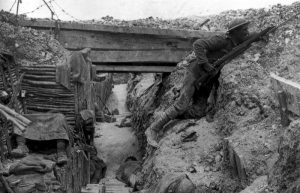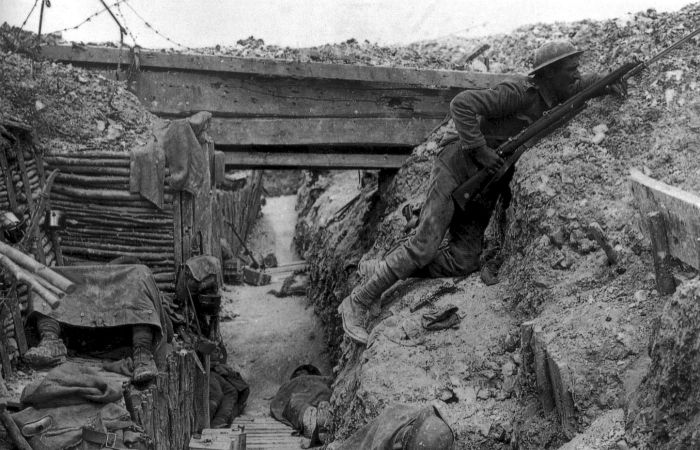Are there really no atheists in foxholes? A new paper looks at the effects of military combat on American service members’ religiosity—and its results do indeed offer some support for that old adage.
 The United States is the most religious developed nation in the world. According to data from the General Social Survey, nearly 90 percent of American adults claim a belief in God, 44 percent attend religious services at least once per month, and 73 percent assert a belief in life after death. Learning to cope with man’s mortality is central to nearly all major religious teachings. However, very little is known about the impact of life-and-death trauma on religiosity.
The United States is the most religious developed nation in the world. According to data from the General Social Survey, nearly 90 percent of American adults claim a belief in God, 44 percent attend religious services at least once per month, and 73 percent assert a belief in life after death. Learning to cope with man’s mortality is central to nearly all major religious teachings. However, very little is known about the impact of life-and-death trauma on religiosity.
War is a life-and-death struggle that generates substantial trauma to service members and their families. Service people deployed to combat face imminent threat of injury and death, and may witness or participate in causing the deaths of enemy combatants, civilians, and comrades-in-arms.
In our new National Bureau of Economic Research working paper, “Death, Trauma and God: The Effect of Military Deployments on Religiosity,” we explore whether an old adage is true: are there really no atheists in foxholes? The effect of life-threatening trauma on religiosity is ex ante uncertain. Fear of death or war-related psychological trauma (including post-traumatic stress disorder) may cause combat veterans to question, or even abandon, religious faith as life-and-death experiences challenge religious doctrines of good and evil. This may cause combat veterans to substitute away from religion and toward secular counseling or even toward risky health behaviors, such as illicit drug use, to numb emotional pain. Alternatively, fear of death and the adverse psychological effects of war could increase religiosity by increasing the demand for social support networks or doctrinal philosophies that promise life after death. In addition, combat could create tighter bonds among service members that generate religious peer effects. Combat deployments may also provide opportunities for military chaplains stationed in combat zones to proselytize in environments where competition from secular counselors is more limited.
The manner in which the US military assigns service members to combat generates the unique conditions for a “natural experiment” that allows us to estimate the causal impact of war-induced life-and-death trauma on religiosity. This experiment boils down to a US Armed Forces philosophy that runs deep; colloquially, “a soldier is a soldier is a soldier.”
Human Resources Command (HRC), which handles assignments of servicemen to their units and assignments of those units to deployment duties, treats branch-specific servicemen of identical military rank and primary military occupation specialty as essentially perfect substitutes for the purposes of these assignments. Senior commanders decide when, where, and for how long to deploy units based on (i) the state of operational environment, which is dictated by world events, and (ii) the readiness and availability of suitable units, determined by equipment availability, timing of training completion, and the occupational composition of unit members (Army Regulation 220-1, 2010). These are largely exogenous factors beyond an individual service member’s control. HRC does not consider personal preferences, religious practices, personality, or family background characteristics in assigning service members to units or deploying units overseas. Service members of identical military rank and occupation (within service branch) are essentially “randomly” assigned to their deployment duties, creating ideal conditions for our natural experiment (Lyle 2006; Engel et al. 2010; Cesur et al. 2013; Sabia and Skimmyhorn 2018).
To examine the impact of military deployments on religiosity, we use two data sources: (1) the 2007–8 military module of the National Longitudinal Study of Adolescent and Adult Health (NLSAAH), and (2) the 2008 Department of Defense Survey of Health and Related Behaviors Among Active Duty Personnel (HRB). These surveys collect a wide set of information on military deployments, war experiences, psychological and physical health, and religiosity. First, using the NLSAAH, we examine a sample of 482 military servicemen ages 24 to 34 who had served or were currently serving on active duty. Among this group, we find that 76 percent reported deployment assignments to combat zones and 24 percent reported deployment assignments exclusively to non-combat zones. These deployments occurred largely during the post-9/11 wars in Afghanistan and Iraq. Among those assigned to combat zones, 49 percent reported engaging the enemy in firefight during war deployments. In addition to these measures of war experiences, we also look at several measures of religiosity among servicemen, including whether and how frequently they attended religious services, the importance of religion to them, and the frequency with which they prayed during the week (outside of religious services).
An important advantage of the NLSAAH data is that it is longitudinal in nature. Thus, we can observe the religiosity of deployed servicemen before they enlisted in the Armed Forces and test whether those deployed to combat were different in their religiosity than those deployed to non-combat operations prior to their enlistment. We find no evidence that they differ in pre-enlistment religiosity.
Results from the NLSAAH show that servicemen assigned to combat zones are 8.9 percentage points more likely to attend weekly religious services in the past year than their counterparts deployed to non-combat zones. Those assigned to combat are also 8.9 percentage points more likely to engage in private prayer, and 4.3 percentage points more likely to report religion is important to them. These estimates are consistent with the hypothesis that life-and-death shocks induce increases in both religious service attendance as well as private religious practices. We also explore whether the effects differ by whether the combat serviceman had separated from the military at the time of the NLSAAH survey. We find that the impact of combat assignment on religious attendance and private prayer is statistically equivalent for those whose active duty service was ongoing at the time of the NLSAAH and those who had separated from the military. This could suggest that the impact of combat on religious practices persists over time.
Next, we turn to the Department of Defense’s 2008 HRB survey. These data are designed to be representative of active duty service members in all branches and pay grades of the US Armed Forces. Thus, a key advantage of these data are that they are more representative of the entire US military than the small NLSAAH sample. Our analysis sample consists of 11,598 respondents and includes information on both military deployments and religiosity. This large sample allows us to explore whether the effects of combat on religiosity differ among subgroups of servicemen, including those serving in particular branches and of particular ages. Important disadvantages of these data are that they are not longitudinal in nature and lack detailed occupation information.
In the main, our findings from the HRB survey largely confirm our NLSAAH results. We find that engaging the enemy in firefight is associated with a 1.9 percentage-point increase in the probability of frequent religious attendance, a 1.4 percentage-point increase in the likelihood of prayer at times of stress or depression, and a 1.9 percentage-point increase in the probability that a serviceman reports that religion is important. The magnitudes of these estimates are somewhat smaller than those obtained from the NLSAAH, which may be explained, in part, by differences in measures of combat assignment. It may also reflect that those who are deployed to combat zones, but not actually exposed to combat, experience increases in religiosity due to fear of life-and-death trauma, or engagement with military chaplains. In addition, we find that being physically wounded in war has a particularly large impact on religiosity. This finding suggests that demand for religion rises sharply in response to physical trauma.
For whom are the religious effects of military deployments largest? Our results suggest that the effect of combat on religiosity is generally larger for soldiers, marines, and sailors as compared to airmen. This is consistent with evidence that the psychological costs of combat are largest for those in the Army and Marines as compared to the Air Force. In addition, we find that these religious effects are largest for younger enlisted servicemen (ages 18 to 24). For officers and older servicemen, there is much less evidence of a turn to religion in response to combat deployments.
We posit that there may be many interrelated mechanisms to explain our findings: (1) servicemen seeking out religious organizations and doctrines to cope with fear of death, (2) adverse psychological effects of war, including PTSD, (3) physical wounding in war, (4) religious peer effects forged by bonds created among combat veterans, and (5) the role the US military itself, wittingly or unwittingly, in nudging servicemen toward religiosity via chaplain services in combat zones. When we empirically try to disentangle some of these channels, we find that the roles of psychological trauma and physical wounding in war are particularly important.
We cannot rule out that the role chaplains play may be important as well. As part of a strategy to aid service members at risk of exposure to war-related trauma, the US Department of Defense funds religiously based counseling services for service members via the military chaplaincy. A 2006 Congressional report concluded that there were 2,859 regular duty chaplains and 1,740 reserve chaplains serving as members of the Armed Forces (Jindal 2006). There is a vigorous policy debate about how well the US Armed Forces has achieved a proper balance in making spiritual services available for those who demand them, while not using publicly funded resources to proselytize for a particular religion. Some argue that the presence of chaplains in combat has led to unconstitutional proselytizing and endangered combat veterans’ mental health. On the other hand, others argue that chaplains are essential not only to meeting the demand for religion by servicemen, but also for successful completion of military operations. While our findings suggest that combat-induced religiosity is not solely, or even largely, attributable to chaplain-induced demand, the role of chaplains in providing counseling services remains a military policy issue worthy of further study.
Travis Freidman is a PhD candidate in Economics at the University of New Hampshire, Resul Cesur is Associate Professor of Healthcare Economics at the University of Connecticut, and Joseph J. Sabia is Professor of Economics & Director of the Center for Health Economics & Policy Studies at San Diego State University and the University of New Hampshire.
References
Army Regulation 220-1, 2010. Army Unit Status Reporting and Force Registration—Consolidated Policies. Headquarters of the Department of the Army, Washington DC, http://www.apd.army.mil/pdffiles/r220 1.pdf
Cesur, Resul, Joseph J. Sabia, and Erdal Tekin. “The Psychological Costs of War: Military Combat and Mental Health.” Journal of Health Economics (2013)
Engel, Rozlyn C., Luke B. Gallagher, and David S. Lyle. “Military deployments and children’s academic achievement: Evidence from Department of Defense Education Activity Schools.” Economics of Education Review 29, no. 1 (2010): 73-82.
Jindal, Congressman Bobby. 2006. Report on Chaplaincy. Obtained on September 28, 2006.
Lyle, David S. “Using military deployments and job assignments to estimate the effect of parental absences and household relocations on children’s academic achievement.” Journal of Labor Economics 24, no. 2 (2006): 319-350.
Sabia, Joseph J. and William Skimmyhorn. “War! What is it Good For? The Effect of Combat Service on the Economic Transitions of Veterans.” Economic Self-Sufficiency Policy Research Institute Working Paper (2018). Available here.
Disclaimer: The ProMarket blog is dedicated to discussing how competition tends to be subverted by special interests. The posts represent the opinions of their writers, not necessarily those of the University of Chicago, the Booth School of Business, or its faculty. For more information, please visit ProMarket Blog Policy.






